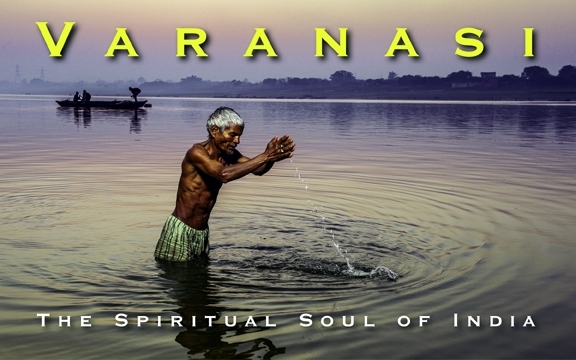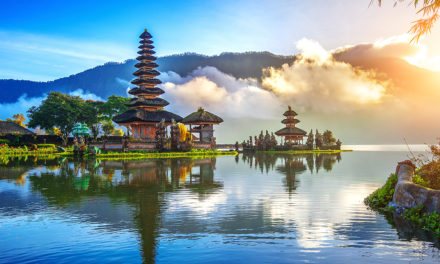Varanasi
The Spiritual Soul of India
by Margaret Deefholts

In the pre-dawn chill of February we walk along the banks of the river Ganges. The eastern sky, swathed in a chiffon-like mist, is pale mauve, but the waters below our boat are dark and mysterious. The morning air smells of wood smoke, cow dung, spices and marigold flowers. Just beyond the ghat steps, a blind beggar sings plaintively.
We are in Benares (now known as Varanasi) a city which embodies the spiritual soul of India, and whose beginnings over 2,500 years ago, are steeped in Hindu mythology. The Ganges, or “Mother Ganga”, India’s holiest river, flows past Varanasi in the course of a 2,600-mile journey-from the remote fastness of the Himalayas, across the fertile northern plains of India, to the Bay of Bengal.
The Ganges is a paradox, both beneficent and destructive by turns. It provides sustenance for millions of people who live along its banks, but it also inflicts merciless flood damage during the monsoons. At Varanasi, it is polluted by raw sewage and charred, putrefying human and animal remains which swirl and float on its surface. Yet, for thousands of Hindu pilgrims who come here daily to bathe, to chant devotional hymns and to scoop its waters in their palms and drink it like a libation, it is a river as pure and ancient as their faith.
Our boatmen take up their oars and, as we pull away from the shore, our guide Ashok invites us to join him in a mantra to the dawn. We hold small clay cups filled with lighted wicks, and at the appropriate moment we set them afloat on the breast of the river. They stream away like a procession of tiny exclamation points bobbing on the dark waters. It is a moment as sacred as the hush in a vaulted cathedral.
The sky grows lighter and the mist begins to dispel. Brazening over the horizon a blood-orange sun turns the river molten and suffuses the city in a golden sheen. As they have done for millennia, devotees gathered at the waters’ edge burst into chanting, their cymbals, drums and conch shells exuberantly heralding the gift of a new day.
The ghats become a shifting pointillist painting, dotted with thousands of people: women bathing fully attired in colorful saris, muscular men stripped to G-strings performing Yoga exercises, naked fakirs (holy men) in pretzel-like poses of meditation, pot-bellied business men clad in white loin-cloths dipping into the waters. Vendors selling chai, cold drinks and hot-gram weave through the crowds. Further upstream, washerwomen exchange gossip and banter, while whacking garments against the stone steps, and laying them out to dry like patchwork quilts at the water’s edge.
Varanasi is a city which celebrates death as no other city in India does. For a Hindu to die in Benares, and to be cremated here on the banks of the Ganga, is to be absolved of karma, freed from the wheel of reincarnation and absorbed into the Infinite.
As we approach the somber Marnikarnika burning ghat, we stow away our cameras and video equipment as photography is prohibited. Sandalwood fires glow and grey smoke smudges the sky. White clad figures-priests and male members of the family- surround the pyres. No weeping here, as this would retard the soul in its journey to fuse with the Ultimate. The ashes will be scattered onto the waters of the Ganges.
We disembark at the main Dasaswamedh Ghat steps, and from the austerity of death, we are plunged into seething life: the lanes of the old city. Some of these are no wider than two people walking abreast, and we shoulder our way past goats, stray dogs dozing in the shade and phlegmatic cud-chewing holy cows.
The lanes are honey-combed by stalls selling silk carpets, Varanasi brocade saris, fine-spun gold jewellery as well as flower garlands, vegetables, fruit and spices. Sadhus, mendicants, vendors and citizens churn against bemused looking tourists. The clamor and smell of humanity throngs the senses.
Later, as dusk creeps over the city, we attend the mystical Aarti ceremony on the banks of the sacred river where, to the haunting notes of the shenai and ringing of bells, priests on rose petal strewn platforms chant an evening mantra to Mother Ganga. The incense from the burning lamps mingle with the scent of marigolds and dust in a shimmering mirage-like scene of spiritual worship.
Like India itself, Varanasi is paradoxical. It is mystical and mundane. Harmonious and discordant. Fascinating and repulsive. A place where the pulse of eternity throbs to the rhythm of an ancient culture.
www.incredibleindia.org/en
Click on cover to view published article


















